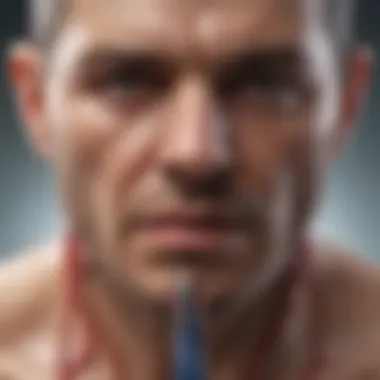Hypertension and Headaches: Understanding the Link


Intro
The intersection between hypertension and headaches poses a significant area of inquiry for healthcare professionals and patients alike. Understanding the physiological mechanisms that link elevated blood pressure with headache symptoms could lead to more effective management strategies. A comprehensive exploration of this relationship sheds light on various types of headaches associated with hypertension, as well as the potential implications for individuals affected by chronic conditions.
Hypertension, often termed the silent killer, frequently masquerades without overt symptoms. Yet its potential to induce headaches is a concern that merits focused investigation. This article aims to explore the dynamics of hypertension and headaches, offering insights into their relationship and the importance of targeted research.
Methodologies
Description of Research Techniques
To examine the link between hypertension and headaches, researchers utilize a combination of quantitative and qualitative methods. Surveys and interviews with patients provide vital anecdotal evidence, while clinical studies offer statistically significant data. One particularly effective technique might involve longitudinal studies that observe patients over time, correlating blood pressure readings with headache occurrences. This helps to establish temporal relationships and causative factors between hypertension and headache disorders.
Tools and Technologies Used
Medical professionals often employ several tools and technologies to measure blood pressure accurately and assess headache impact:
- Blood Pressure Monitors: Automatic digital monitors offer precise readings for daily tracking.
- Pain Assessment Scales: Tools like the Visual Analog Scale (VAS) assist in quantifying headache severity.
- EEG and MRI: Advanced imaging techniques may be used in study settings to observe brain activity in patients suffering from headaches while hypertensive.
Discussion
Comparison with Previous Research
Previous studies have indicated a potential correlation between hypertension and headaches, though results have often varied. Some research suggests that individuals with hypertension may experience more frequent tension-type and migraine headaches compared to normotensive individuals. Such findings necessitate a reevaluation of existing hypotheses regarding headache pathology.
Theoretical Implications
Understanding the underlying mechanisms may also have implications for developing treatment protocols. If an established link is confirmed, healthcare providers might consider integrating blood pressure management strategies into headache treatment plans. This could lead to improved outcomes for those suffering from both conditions, fostering a more holistic approach to patient care.
"Integrating blood pressure monitoring into headache management may enhance treatment efficacy and alleviate patient suffering."
Future research should continue to investigate these connections, seeking to discern the multifaceted relationship between hypertension and headaches. The potential for improved patient outcomes relies on a commitment to advancing our understanding of these intertwined health issues.
Understanding Hypertension
Hypertension, often referred to as high blood pressure, represents a significant medical condition with widespread implications. Understanding hypertension is crucial for various reasons. First, it serves as a foundational element in comprehending its connection to headaches, which is the focus of this article. Elevated blood pressure can trigger multiple physiological reactions that may lead to headache symptoms. Moreover, recognizing hypertension's multifaceted impact can aid clinicians and researchers in providing better patient care and focused treatment strategies.
Definition of Hypertension
Hypertension is defined as a chronic medical condition wherein the blood pressure in the arteries is persistently elevated. Blood pressure is measured using two values: systolic pressure, which represents the force of blood against the artery walls during heartbeats, and diastolic pressure, indicating the pressure when the heart is at rest between beats. According to the American Heart Association, a normal blood pressure reading is below 120/80 mm Hg. A reading of 130/80 mm Hg or higher is categorized as hypertension. This condition can go unnoticed for many individuals, but over time it can lead to serious health complications, including cardiovascular diseases and renal issues.
Prevalence and Impact
Hypertension affects a considerable portion of the population globally. Recent statistics indicate that nearly 1 in 3 adults in the United States suffers from hypertension. This prevalence underscores the importance of recognizing and addressing high blood pressure, as it is a leading risk factor for both heart disease and stroke. The impact of hypertension is extensive, often leading to a decline in quality of life due to associated complications and comorbid conditions.
The ramifications extend beyond acute physical health, influencing mental well-being and the overall healthcare system burden. Increased medical costs, loss of productivity, and the demand for extensive management and treatment options illustrate the significance of addressing hypertension and its implications. This backdrop is essential to explore the intricate relationship between hypertension and headaches, laying the groundwork for understanding various headache types that may stem from this pressing health issue.
Headaches: An Overview
Understanding headaches is crucial in the context of this article. Hypertension, commonly known as high blood pressure, is a prevalent condition that can significantly impact various aspects of health, including headaches. By delving into the nature of headaches, we can better appreciate how they relate to hypertension, providing insight valuable for both healthcare professionals and patients.
Headaches are not just mere discomfort; they can affect daily functioning and overall quality of life. The implications of these pain episodes extend beyond immediate relief, influencing mood, productivity, and social interactions. Thus, recognizing the connection between hypertension and headaches can lead to more informed decisions regarding treatment and management.
The classification of headaches helps us understand their differences, guiding treatment options. It examines characteristics such as duration, intensity, and triggers, all of which are relevant when considering how hypertension may exacerbate headache symptoms.
Furthermore, identifying common types of headaches aids in distinguishing which headaches may be linked to high blood pressure. This knowledge can assist in tailoring effective management strategies, whether they involve pharmacological interventions or lifestyle changes.
"Headaches may be a symptom of underlying health issues, including hypertension, making their study a critical component in holistic care."


In summary, this section sets the groundwork for exploring headaches further, emphasizing the relationship between hypertension and headache types. As we move forward, recognizing the nuances of headache classification and their common manifestations will enrich our understanding of this interconnection and its implications in both clinical and personal contexts.
Classification of Headaches
Headaches can be classified into two main categories: primary and secondary headaches. Primary headaches are not caused by any underlying condition. Instead, they occur independently and can include tension headaches, migraines, and cluster headaches. Secondary headaches, on the other hand, stem from other medical conditions; hypertension can be a contributing factor here. Understanding this classification is critical for effective diagnosis and treatment, allowing healthcare providers to discern the potential role of hypertension in headache symptoms.
Common Types of Headaches
Common types of headaches include:
- Tension Headaches: Characterized by a dull, aching sensation all over the head. This type may be linked to stress and tension, making it significant in individuals with hypertension.
- Migraines: Often manifesting with severe pulsing or throbbing pain, usually on one side of the head. They can be triggered by various factors, including hormonal, environmental, and even increased blood pressure.
- Cluster Headaches: These occur in cyclical patterns or clusters, causing intense pain, typically around one eye. The relationship with hypertension can complicate their management.
Understanding these common types of headaches, their distinguishing features and triggers, further illustrates how hypertension can play a pivotal role in headache severity and frequency. This awareness fosters improved management strategies and treatment decisions.
Mechanisms Linking Hypertension and Headaches
Understanding the mechanisms that connect hypertension to headaches is essential for several reasons. First, identifying these connections helps health care professionals assess the impact of elevated blood pressure on patients. Second, knowing how migraines and tension-type headaches may stem from hypertension can guide treatment strategies. Finally, this knowledge fosters the development of preventive approaches to reduce headache frequency in hypertensive individuals.
Physiological Responses
Hypertension invites various physiological responses within the body. When blood pressure increases, the body's reaction involves several systems. The nervous system plays a critical role, as it can stimulate pain pathways. For instance, in times of high blood pressure, increased strain on blood vessels may trigger a series of signals that result in headache symptoms.
Hormonal changes also contribute. Specifically, the body releases stress hormones like adrenaline. This situation can lead to heightened sensitivity. As a result, when blood pressure rises, even normal stimuli might trigger headaches. Understanding these physiological changes is crucial for distinguishing between stress-related headaches and those directly caused by hypertension.
Vascular Changes
Hypertension fundamentally alters vascular dynamics. The increased pressure on arterial walls leads to structural changes. Over time, blood vessels may narrow or stiffen, a condition known as vascular remodeling. Such changes can compromise blood flow, particularly to the brain.
One significant impact of this is the potential for ischemic conditions. Reduced blood flow to crucial areas can lead to hypoxia, resulting in headaches. Moreover, damaged blood vessels may become more permeable, allowing fluids to leak into surrounding tissues. This leakage can increase intracranial pressure, further contributing to headache severity.
- Affected conditions may include:
- Increased headache frequency.
- Elevated headache intensity.
In summary, hypertension brings forth various physiological and vascular changes that can lead to headaches. Beyond simply understanding these mechanisms, adequate management strategies can utilize this knowledge to improve patient outcomes.
Headache Types Associated with Hypertension
The connection between hypertension and headaches is multifaceted. Understanding the different headache types associated with elevated blood pressure helps in grasping the overall relationship. It is crucial because it enables proper recognition and treatment of headache symptoms in patients with hypertension. Patients can experience varied headache types, and recognizing these can lead to more effective management of both conditions.
Identifying headache types can guide healthcare professionals in tailoring specific treatment plans. People suffering from chronic hypertension may not attribute their headaches to this underlying issue. Thus, exploring this intersection is not just beneficial; it is vital for improving patient quality of life and preventing long-term complications.
Tension Headaches
Tension headaches are the most common type of headache and often occur in individuals with hypertension. They typically manifest as a dull, aching sensation around the head, characterized by pressure or tightness. People often describe it as a band-like feeling encircling their head.
The exact cause of tension headaches is still unclear, but stress and muscle tension are significant contributors. In hypertension patients, stress may exacerbate both conditions. Lifestyle factors such as poor posture, anxiety, and lack of sleep may also play a role.
"Recognizing tension headaches, especially in hypertensive patients, is crucial because it may signal uncontrolled blood pressure or other stressors."
Effective management focuses on stress relief and lifestyle adjustments. Techniques such as relaxation therapy, cognitive behavioral therapy, and physical exercise can help alleviate these headaches. Pain relievers may also be necessary for acute episodes but should be used judiciously.
Migraines
Migraines tend to be more severe than tension headaches, often recurring as episodes. Patients may experience throbbing pain, usually localized to one side of the head. In those with hypertension, migraines can also serve as a warning sign, indicating that blood pressure might need better management.
Migraine triggers vary but may include dietary factors, hormonal shifts, or even stress. The presence of hypertension can compound these triggers, making individuals more vulnerable to migraine attacks. Studies suggest a correlation between high blood pressure and increased migraine frequency.


Treatment is multifaceted, usually involving both lifestyle changes and medications. Preventive strategies may include dietary adjustments, adequate hydration, and regular inconsistent sleep patterns. Furthermore, certain medications designed to regulate blood pressure may also help in reducing migraine occurrences.
Hypertensive Crisis Headaches
Hypertensive crisis headaches represent a more severe linkage between hypertension and headaches. These headaches arise when blood pressure rapidly escalates to dangerous levels. The pain experienced in these cases can be abrupt, intense, and differentiated from other headache types.
Symptoms of hypertensive crisis include chest pain, shortness of breath, and severe headache, often requiring immediate medical attention. These headaches can indicate significant changes in vascular integrity and could precede complications such as stroke or heart attack. Recognizing the signs and symptoms in patients is critical for timely intervention.
Once identified, immediate treatment may involve hospital-based management of blood pressure, along with pain control. Long-term strategies must address hypertension management rigorously to prevent recurrence of such debilitating headaches.
Overall, understanding the various headache types associated with hypertension is paramount. In doing so, patients and clinicians can work together to address underlying causes, implement preventive measures, and ultimately improve patient outcomes.
Diagnosis of Hypertension-Related Headaches
Diagnosing headaches linked to hypertension is crucial for effective management. Understanding this relationship allows healthcare providers to tailor treatment plans that not only address the headache symptoms but also target the underlying hypertension. This dual focus can lead to improved patient outcomes, heightened quality of life, and a decrease in potential complications from untreated hypertension. When patients experience headaches, it is essential to consider their blood pressure history, as this may provide valuable insights into the type and severity of the headaches.
Medical History Review
A thorough review of the patient's medical history is the first step in diagnosing hypertension-related headaches. This process involves gathering information about the patient's headache patterns, including frequency, duration, and intensity. Medical practitioners should inquire about any previous diagnosis of hypertension and the patient's treatment history, given that chronic hypertension may influence headache characteristics.
Additionally, it is important to document any family history of headaches or cardiovascular issues. This can supply context regarding potential hereditary factors that might contribute to the patient's condition. Other considerations during this review may include:
- Medication usage, particularly those for managing blood pressure or pain relief.
- Lifestyle factors, such as diet, physical activity, and stress levels.
- Presence of any additional symptoms that might indicate a more serious condition.
This comprehensive approach helps to ensure that healthcare providers can accurately differentiate between primary headaches and those associated with hypertension.
Diagnostic Tests
Beyond medical history, diagnostic tests play a significant role in confirming the link between hypertension and headaches. Primary among these is the measurement of blood pressure. Elevated readings can not only confirm a diagnosis of hypertension but can also aid in understanding the pattern of headaches experienced by the patient.
Some diagnostic tests may include:
- 24-hour Ambulatory Blood Pressure Monitoring: This provides a detailed profile of blood pressure changes throughout the day and can yield important information about blood pressure behavior.
- Blood Tests: These tests help rule out other underlying issues, such as metabolic or endocrine disorders that may contribute to both headaches and hypertension.
- Imaging Studies: MRI or CT scans may be indicated if there are unusual headache patterns that suggest a secondary cause unrelated to hypertension.
Early diagnosis and management of hypertension-related headaches can significantly improve a patient's quality of life, reducing the risk of progression to more severe complications.
Engaging in a detailed medical history review followed by appropriate diagnostic testing can provide a clearer picture of how hypertension affects headache occurrence and severity. This informed approach lays groundwork for a targeted management strategy.
Management Strategies
The management of headaches linked to hypertension is crucial for both alleviating symptoms and addressing the underlying causes. This section highlights the significance of effective strategies that can improve patient outcomes. Understanding and applying appropriate management can lead to a reduction in headache frequency and intensity. This is especially important for people who experience chronic headaches alongside hypertension.
Pharmacological Treatments
Pharmacological treatments represent a primary approach in managing hypertension-related headaches. These medications can include both antihypertensives and analgesics.
- Antihypertensives: Medications like lisinopril or amlodipine can help lower blood pressure, which may simultaneously reduce headache frequency due to hypertensive fluctuations.
- Analgesics: Nonsteroidal anti-inflammatory drugs (NSAIDs) such as ibuprofen or naproxen can provide immediate relief from headache pain. For chronic headache management, doctors may prescribe triptans for migraine sufferers or other specific migraine medications.
The choice of medication will depend on the patient's overall health, other medical conditions, and potential drug interactions. Regular follow-ups with healthcare professionals are necessary to monitor the effectiveness of medications and adjust dosages if needed.
Non-Pharmacological Approaches
Apart from medications, non-pharmacological approaches play an integral role in managing headaches related to hypertension. These strategies focus on lifestyle modifications and alternative therapies, which can complement pharmacological treatments.
- Lifestyle Modifications:
- Stress Management Techniques:
- Physical Therapies: Physical therapy or chiropractic care may provide relief for some individuals by correcting posture and reducing tension in neck and shoulder muscles.
- Diet: A sodium-restricted diet can help lower blood pressure. Incorporating more fruits, vegetables, and whole grains is beneficial.
- Exercise: Regular physical activity aids in blood pressure control and stress reduction, both of which can decrease headache occurrence.
- Sleep: Prioritizing sleep and maintaining a stable sleep schedule can reduce headache triggers.


- Cognitive Behavioral Therapy (CBT): This can help patients identify and manage stressors contributing to both hypertension and headaches.
- Mindfulness and Relaxation Techniques: Practices like yoga and meditation can improve stress response and lower blood pressure.
The integration of both pharmacological and non-pharmacological strategies offers a multi-faceted approach to effectively manage headaches stemming from hypertension.
Preventive Measures for Hypertension
Preventive measures for hypertension play a critical role in both the management of blood pressure and the prevention of associated complications, including headaches. Addressing hypertension proactively can lead to better long-term health outcomes and enhance the overall quality of life. Individuals with high blood pressure often experience a range of symptoms, with headaches being a significant concern.
Implementing preventive strategies can mitigate the risk of chronic hypertension and its related symptoms. These measures are not only essential for those already diagnosed with hypertension but also for individuals who may be at risk due to various factors such as family history, lifestyle choices, and environmental influences.
Lifestyle Modifications
Lifestyle modifications are a cornerstone of hypertension prevention. Simple changes in daily habits can lead to significant improvements in blood pressure levels and, consequently, headache management.
- Dietary Changes: A diet rich in fruits, vegetables, whole grains, and lean proteins can lower blood pressure. The DASH (Dietary Approaches to Stop Hypertension) diet is a proven method that emphasizes reducing sodium intake and increasing potassium-rich foods.
- Physical Activity: Engaging in regular physical activity, like walking or swimming, can help maintain a healthy weight and lower blood pressure. Aim for at least 150 minutes of moderate-intensity exercise each week.
- Weight Management: Maintaining a healthy weight is crucial. Even a modest weight loss can help reduce blood pressure levels.
- Limiting Alcohol and Tobacco Use: Both substances can contribute to elevated blood pressure. Reducing intake or quitting altogether can have beneficial effects.
These modifications require consistency and dedication. However, the benefits extend beyond blood pressure control. They also improve general health and decrease the risk of headaches.
Regular Monitoring
Regular monitoring of blood pressure is vital for those at risk or already diagnosed with hypertension. It serves as an early warning system for any potential complications, including headaches.
- Self-Monitoring Techniques: Using home blood pressure monitors can empower individuals to track their readings regularly. This enables timely adjustments in lifestyle or medication based on trends observed.
- Healthcare Follow-ups: Routine visits to healthcare providers allow for professional assessments of blood pressure and overall health status. These visits offer opportunities for adjustments in treatment plans and education on best practices.
- Recognizing Symptoms: Understanding the signs of high blood pressure and related headaches can guide prompt action. Keeping a headache diary may help identify triggers and patterns linked to hypertension.
Regular monitoring and timely interventions are vital in preventing the long-term consequences of hypertension.
Monitoring not only helps in quick reactions to any alarming changes but also fosters a proactive approach to overall health management. By remaining vigilant, individuals can significantly reduce their risk of headaches and other hypertension-linked health issues.
Chronic Hypertension and Long-Term Headache Outcomes
Chronic hypertension is a persistent elevation in blood pressure levels, and it holds significant importance in understanding headache conditions. This section examines how long-term hypertension can interact with headache symptoms and their frequency. Over time, untreated or poorly managed high blood pressure can lead to various complications, including those involving the nervous system.
Cumulative Effects
The cumulative effects of chronic hypertension can impact the frequency and intensity of headaches. Patients with ongoing high blood pressure may experience a higher rate of headache incidence. The constant stress on blood vessels can lead to changes in their structure and function, influencing how tension headaches and migraines manifest.
Research indicates that as hypertension persists, individuals may report headaches more frequently. This change may be due to long-term alterations in vascular responsiveness, which could enhance headache triggers. Regular episodes might make patients increasingly sensitive to pain, compounding their overall suffering.
Quality of Life Considerations
Chronic hypertension's impact on headaches extends to quality of life issues. Living with frequent headaches can be debilitating, affecting daily activities, work performance, and social interactions. Individuals may begin to avoid certain situations or activities they associate with headache triggers, leading to isolation and frustration.
Additionally, the emotional aspect of suffering from both hypertension and headaches can lead to increased anxiety and depression. The dual burden changes how individuals perceive their health status and can contribute to a more anxious outlook on life.
Healthcare professionals should assess not only the medical but also the psychological impacts of chronic hypertension and headaches. Traditional treatments for hypertension might not be sufficient if headache management is not integrated into the care plan. Encouraging holistic approaches may improve overall well-being for these patients, addressing both physical and mental health needs.
Research Gaps and Future Directions
Need for More Studies
The existing literature on the connection between hypertension and headaches is insufficient. Studies often focus on either condition without exploring their interaction in depth. This disparity creates a significant knowledge gap.
One area needing attention is the long-term effects of chronic hypertension on headache frequency and severity. Additionally, the variations among diverse populations require investigation. Certain demographics may experience different responses or types of headaches linked to hypertension. Therefore, researchers need to consider broader and more inclusive clinical trials.
Another point is the role of comorbidities. Conditions like diabetes or sleep apnea may influence headache patterns in hypertensive patients. By incorporating these factors, future studies can offer a more holistic view of the issue.
Potential for New Therapies
As research evolves, there are opportunities for developing new therapies. Innovative approaches could target the specific mechanisms connecting hypertension and headaches. Current treatments may not adequately address all symptoms related to elevated blood pressure.
For instance, targeted medications that address both hypertension and headache relief could improve the quality of life for patients. Combination therapies may offer an effective solution. Exploring biofeedback and mindfulness techniques might yield non-pharmacological strategies that help manage symptoms.
Furthermore, ongoing research could lead to breakthroughs in personalized medicine. Understanding genetic predispositions may allow healthcare providers to tailor treatments for specific patient needs, enhancing effectiveness.
By systematically addressing these areas, the medical community can ensure that patient care is effective and informed.



